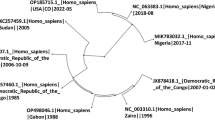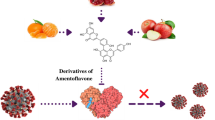Abstract
The proteins involved in the autophagy (Atg) pathway have recently been considered promising targets for the development of new antimalarial drugs. In particular, inhibitors of the protein–protein interaction (PPI) between Atg3 and Atg8 of Plasmodium falciparum retarded the blood- and liver-stages of parasite growth. In this paper, we used computational techniques to design a new class of peptidomimetics mimicking the Atg3 interaction motif, which were then synthesized by click-chemistry. Surface plasmon resonance has been employed to measure the ability of these compounds to inhibit the Atg3–Atg8 reciprocal protein–protein interaction. Moreover, P. falciparum growth inhibition in red blood cell cultures was evaluated as well as the cyto-toxicity of the compounds.











Similar content being viewed by others
Abbreviations
- PE:
-
Phosphatidylethanolamine
- PPI:
-
Protein–protein interactions
- MD:
-
Molecular dynamics
- SPR:
-
Surface plasmon resonance
References
World Health Organization (2017) http://www.who.int/mediacentre/factsheets/fs094/en/. Accessed 16 may 2017
Ashley E, McGready R, Proux S, Nosten F (2006) Malaria. Travel Med Infect Dis 4:159–173. https://doi.org/10.1016/j.tmaid.2005.06.009
Maeno Y, Culleton R, Quang NT, Kawai S, Marchand RP, Nakazawa S (2016) Plasmodium knowlesi and human malaria parasites in Khan Phu, Vietnam: gametocyte production in humans and frequent co-infection of mosquitoes. Parasitology 144:527–535. https://doi.org/10.1017/S0031182016002110
Dondorp AM, Nosten F, Yi P, Das D, Phyo AP, Tarning J, Lwin KM, Ariey F, Hanpithakpong W, Lee SJ, Ringwald P, Silamut K, Imwong M, Chotivanich K, Lim P, Herdman T, An SS, Yeung S, Singhasivanon P, Day NPJ, Lindegardh N, Socheat D, White NJ (2009) Artemisinin resistance in Plasmodium falciparum malaria. New Engl J Med 361:455–467. https://doi.org/10.1056/NEJMoa0808859
Dondorp AM, Yeung S, White L, Nguon C, Day NPJ, Socheat D, von Seidlein L (2010) Artemisinin resistance: current status and scenarios for containment. Nat Rev Microbiol 8:530–530. https://doi.org/10.1038/nrmicro2385
Beesley T, Gascoyne N, Knott-Hunziker V, Petursson S, Waley SG, Jaurin B, Grundström T (1983) The inhibition of class C β-lactamases by boronic acids. Biochem J 209:229–233. https://doi.org/10.1042/bj2090229
World Health Organization (2017) Malaria vaccine: WHO position paper, January 2016—Recommendations. Vaccine. https://doi.org/10.1016/j.vaccine.2016.10.047
Jana S, Paliwal J (2007) Novel molecular targets for antimalarial chemotherapy. Int J Antimicrob Agents 30:4–10. https://doi.org/10.1016/j.ijantimicag.2007.01.002
Ettari R, Micale N, Grazioso G, Bova F, Schirmeister T, Grasso S, Zappalà M (2012) Synthesis and molecular modeling studies of derivatives of a highly potent peptidomimetic vinyl ester as falcipain-2 inhibitors. ChemMedChem 7:1594–1600. https://doi.org/10.1002/cmdc.201200274
Marco M, Coteron JM (2012) Falcipain inhibition as a promising antimalarial target. Curr Top Med Chem 12:408–444
Alvarez VE, Kosec G, Sant’Anna C, Turk V, Cazzulo JJ, Turk B (2008) Autophagy is involved in nutritional stress response and differentiation in Trypanosoma cruzi. J Biol Chem 283:3454–3464. https://doi.org/10.1074/jbc.M708474200
Sinai AP, Roepe PD (2012) Autophagy in Apicomplexa: A life sustaining death mechanism?. Trends Parasitol 28:358–364. https://doi.org/10.1016/j.pt.2012.06.006
Hain AUP, Weltzer RR, Hammond H, Jayabalasingham B, Dinglasan RR, Graham DRM, Colquhoun DR, Coppens I, Bosch J (2012) Structural characterization and inhibition of the Plasmodium Atg8–Atg3 interaction. J Struct Biol 180:551–562. https://doi.org/10.1016/j.jsb.2012.09.001
Besteiro S (2012) Which roles for autophagy in Toxoplasma gondii and related apicomplexan parasites? Mol Biochem Parasitol 184:1–8. https://doi.org/10.1016/j.molbiopara.2012.04.001
Chen D, Lin J, Liu Y, Li X, Chen G, Hua Q, Nie Q, Hu X, Tan F (2016) Identification of TgAtg8–TgAtg3 interaction in Toxoplasma gondii. Acta Trop 153:79–85. https://doi.org/10.1016/j.actatropica.2015.09.013
Geng J, Klionsky DJ (2008) The Atg8 and Atg12 ubiquitin-like conjugation systems in macroautophagy. Embo Rep 9:859
Abada A, Elazar Z (2014) Getting ready for building: signaling and autophagosome biogenesis. Embo Rep 15:839
Le Roch KG, Zhou Y, Blair PL, Grainger M, Moch JK, Haynes JD, De La Vega P, Holder AA, Batalov S, Carucci DJ, Winzeler EA (2003) Discovery of gene function by expression profiling of the malaria parasite life cycle. Science 301:1503–1508. https://doi.org/10.1126/science.1087025
Duszenko M, Ginger ML, Brennand A, Gualdrón-López M, Colombo MI, Coombs GH, Coppens I, Jayabalasingham B, Langsley G, Lisboa de Castro S, Menna-Barreto R, Mottram JC, Navarro M, Rigden DJ, Romano PS, Stoka V, Turk B, Michels PAM (2011) Autophagy in protists. Autophagy 7:127–158. https://doi.org/10.4161/auto.7.2.13310
Hain AU, Miller AS, Levitskaya J, Bosch J (2016) Virtual screening and experimental validation identify novel inhibitors of the Plasmodium falciparum Atg8–Atg3 protein–protein interaction. ChemMedChem 11:900–910. https://doi.org/10.1002/cmdc.201500515
Hain AUP, Bartee D, Sanders NG, Miller AS, Sullivan DJ, Levitskaya J, Meyers CF, Bosch J (2014) Identification of an Atg8–Atg3 Protein–Protein interaction inhibitor from the medicines for malaria venture malaria box active in blood and liver stage Plasmodium falciparum parasites. J Med Chem 57:4521–4531. https://doi.org/10.1021/jm401675a
Scott DE, Bayly AR, Abell C, Skidmore J (2016) Small molecules, big targets: drug discovery faces the protein–protein interaction challenge. Nat Rev Drug Discov 15:533–550. https://doi.org/10.1038/nrd.2016.29
Valverde IE, Mindt TL (2013) 1,2,3-Triazoles as amide-bond surrogates in peptidomimetics. Chimia 67:262–266
Stucchi M, Grazioso G, Lammi C, Manara S, Zanoni C, Arnoldi A, Lesma G, Silvani A (2016) Disrupting the PCSK9/LDLR protein–protein interaction by an imidazole-based minimalist peptidomimetic. Org Biomol Chem 14:9736–9740. https://doi.org/10.1039/C6OB01642A
Ni Z, Giordano L, Tenaglia A (2014) Cyclobutene formation in PtCl2-catalyzed cycloisomerizations of heteroatom-tethered 1,6-enynes. Chem-Eur J 20:11703–11706. https://doi.org/10.1002/chem.201403643
Masciocchi D, Gelain A, Porta F, Meneghetti F, Pedretti A, Celentano G, Barlocco D, Legnani L, Toma L, Kwon B-M, Asaid A, Villa S (2013) Synthesis, structure–activity relationships and stereochemical investigations of new tricyclic pyridazinone derivatives as potential STAT3 inhibitors. MedChemComm 4:1181–1188
Toma L, Legnani L, Rencurosi A, Poletti L, Lay L, Russo G (2009) Modeling of synthetic phosphono and carba analogues of N-acetyl-alpha-D-mannosamine 1-phosphate, the repeating unit of the capsular polysaccharide from Neisseria meningitidis serovar A. Org Biomol Chem 7:3734–3740. https://doi.org/10.1039/b907000a
Luparia M, Legnani L, Porta A, Zanoni G, Toma L, Vidari G (2009) Enantioselective synthesis and olfactory evaluation of bicyclic alpha- and gamma-ionone derivatives: the 3D arrangement of key molecular features relevant to the violet odor of ionones. J Org Chem 74:7100–7110. https://doi.org/10.1021/jo9014936
Legnani L, Colombo D, Venuti A, Pastori C, Lopalco L, Toma L, Mori M, Grazioso G, Villa S (2017) Diazabicyclo analogues of maraviroc: synthesis, modeling, NMR studies and antiviral activity. MedChemComm 8:422–433. https://doi.org/10.1039/C6MD00575F
Lee C, Yang W, Parr RG (1988) Development of the Colle-Salvetti correlation-energy formula into a functional of the electron density. Phys Rev B 37:785–789
Becke AD (1993) Density-functional thermochemistry. III. The role of exact exchange. J Chem Phys 98:5648–5652. https://doi.org/10.1063/1.464913
Wolinski K, Hinton JF, Pulay P (1990) Efficient implementation of the gauge-independent atomic orbital method for NMR chemical shift calculations. J Am Chem Soc 112:8251–8260. https://doi.org/10.1021/ja00179a005
Ditchfield R (1974) Self-consistent perturbation theory of diamagnetism. Mol Phys 27:789–807. https://doi.org/10.1080/00268977400100711
Case DA, Darden TA, Cheatham TE III, Simmerling CL, Wang J, Duke RE, Luo R, Walker C, Zhang W, Merz KM, Roberts B, Hayik S, Roitberg A, Seabra G, Swails J, Goetz AW, Kolossváry I, Wong KF, Paesani F, Vanicek J, Wolf RM, Liu J, Wu X, Brozell SR, Steinbrecher T, Gohlke H, Cai Q, Ye X, Wang J, Hsieh MJ, Cui G, Roe DR, Mathews DH, Seetin MG, Salomon-Ferrer R, Sagui C, Babin V, Luchko T, Gusarov S, Kovalenko A, Kollman PA (2012) AMBER 12. University of California, San Francisco
Wang J, Wolf RM, Caldwell JW, Kollman PA, Case DA (2004) Development and testing of a general amber force field. J Comp Chem 25:1157–1174. https://doi.org/10.1002/jcc.20035
Jorgensen WL, Chandrasekhar J, Madura JD, Impey RW, Klein ML (1983) Comparison of simple potential functions for simulating liquid water. J Chem Phys 79:926–935. https://doi.org/10.1063/1.445869
Essmann U, Perera L, Berkowitz ML, Darden T, Lee H, Pedersen LG (1995) A smooth particle mesh Ewald method. J Chem Phys 103:8577–8593
Berendsen HJC, Postma JPM, van Gunsteren WF, DiNola A, Haak JR (1984) Molecular dynamics with coupling to an external bath. J Chem Phys 81:3684–3690. https://doi.org/10.1063/1.448118
Jones G, Willett P, Glen RC, Leach AR, Taylor R (1997) Development and validation of a genetic algorithm for flexible docking. J Mol Biol 267:727–748. https://doi.org/10.1006/jmbi.1996.0897
Korb O, Stutzle T, Exner TE (2009) Empirical scoring functions for advanced protein-ligand docking with PLANTS. J Chem Inf Model 49:84–96. https://doi.org/10.1021/ci800298z
Dallanoce C, Magrone P, Bazza P, Grazioso G, Rizzi L, Riganti L, Gotti C, Clementi F, Frydenvang K, De Amici M (2009) New analogues of epiboxidine incorporating the 4,5-dihydroisoxazole nucleus: synthesis, binding affinity at neuronal nicotinic acetylcholine receptors, and molecular modeling investigations. Chem Biodivers 6:244–259. https://doi.org/10.1002/cbdv.200800077
Nilsson BM, Vargas HM, Ringdahl B, Hacksell U (1992) Phenyl-substituted analogues of oxotremorine as muscarinic antagonists. J Med Chem 35:285–294
Frisch MJ, Trucks GW, Schlegel HB, Scuseria GE, Robb MA, Cheeseman JR, Scalmani G, Barone V, Mennucci B, Petersson GA, Nakatsuji H, Caricato M, Li X, Hratchian HP, Izmaylov AF, Bloino J, Zheng G, Sonnenberg JL, Hada M, Ehara M, Toyota K, Fukuda R, Hasegawa J, Ishida M, Nakajima T, Honda Y, Kitao O, Nakai H, Vreven T, Montgomery JJA, Peralta JE, Ogliaro F, Bearpark M, Heyd JJ, Brothers E, Kudin KN, Staroverov VN, Kobayashi R, Normand J, Raghavachari K, Rendell A, Burant JC, Iyengar SS, Tomasi J, Cossi M, Rega N, Millam JM, Klene M, Knox JE, Cross BJ, Bakken V, Adamo C, Jaramillo J, Gomperts R, Stratmann, ER, Yazyev O, Austin AJ, Cammi R, Pomelli C, Ochterski WJ, Martin RL, Morokuma K, Zakrzewski VG, Voth GA, Salvador P, Dannenberg JJ, Dapprich S, Daniels AD, Farkas Ö, Foresman JB, Ortiz JV, Cioslowski J, Fox DJ (2009) Gaussian09. Revision A.02
Trager W, Jensen JB (1976) Human malaria parasites in continuous culture. Science 193:673–675
Acknowledgements
We acknowledge the CINECA and the Regione Lombardia award under the LISA initiative, for the availability of high performance computing resources and support. We thank the Johns Hopkins Malaria Research Institute parasite and insectary facility for assistance with our experiments. This work was partially funded through The Bloomberg Family Foundation (J.B.). We thank Professors D. Taramelli and M. De Amici for helpful discussion. L. L. thanks the University of Pavia for partial financial support.
Author information
Authors and Affiliations
Contributions
The manuscript was written through contributions of all authors. All authors have given approval to the final version of the manuscript.
Corresponding author
Ethics declarations
Conflict of interest
The authors declare no competing financial interests.
Electronic supplementary material
Below is the link to the electronic supplementary material.
Rights and permissions
About this article
Cite this article
Villa, S., Legnani, L., Colombo, D. et al. Structure-based drug design, synthesis and biological assays of P. falciparum Atg3–Atg8 protein–protein interaction inhibitors. J Comput Aided Mol Des 32, 473–486 (2018). https://doi.org/10.1007/s10822-018-0102-5
Received:
Accepted:
Published:
Issue Date:
DOI: https://doi.org/10.1007/s10822-018-0102-5




